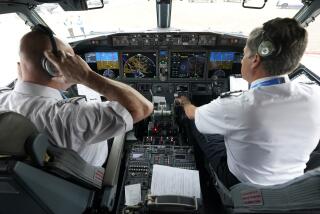Growth of regional airlines raises alarm on safety
- Share via
CHICAGO — Nick Fulks says he met the “bare minimum requirements” when, at age 23, with 1,020 hours of flight experience, he was hired to fly planes for a large commuter airline.
Make no mistake: Fulks loves to fly, and he is a serious student of everything aviation.
But the hours are abysmal, and the pay is so low that Fulks, who had shared an apartment out of economic necessity, is moving back to his parents’ house two years into his career.
Struggles like his -- handling stress and fatigue and mastering a learning curve in the cockpit that plays out over years -- long have been a standard practice in the airline industry. It is aviation’s equivalent of physicians training as residents.
But as regional carriers become big business, some safety experts ask whether pilot fatigue, training and salaries that demand overtime are eroding safety standards.
--
More flights
This sector exploded in size and importance this decade as cash-strapped airlines such as United, American, Delta, Continental and US Airways shrank their regular operations and outsourced more flying to regional or feeder carriers. These contract partners operate planes, which hold between 10 and 100 passengers, emblazoned with the large carriers’ logos.
Once the provider of short puddle-jump flights, regional carriers operate about half of all the commercial airline flights in the U.S. and carry about 20% of commercial airline passengers.
During a four-year stretch after the Sept. 11 attacks, the amount of flying they handled nearly tripled, according to data compiled for the Chicago Tribune by OAG, which tracks airline data.
Commuter airlines are required to meet the same federal safety and training standards as the major airlines. But a recent spate of accidents involving this sector has heightened concerns that rapid growth at some carriers may have jeopardized safeguards.
The February crash of a Colgan Air/Continental Connection plane that killed 50 people near Buffalo, N.Y., has focused attention on flight-training lapses and the financial pressures faced by pilots who are trying to make a living flying smaller planes. Many regional pilots commute cross-country and spend nights in airport crew lounges to save money.
Some question whether the Federal Aviation Administration, whose inspectors are stretched thin, has delegated sufficient resources to the sector.
Like pilots at the airlines they oversee, inspectors handling regional carriers are the most junior at the agency, said Linda Goodrich, an FAA inspector and vice president of the Professional Aviation Safety Specialists, a union representing the inspectors.
But the Regional Airline Assn., a trade group, maintains that its carriers are every bit as safe as their larger counterparts.
“These are not your grandfather’s, or even your father’s, regional airlines. Today we have one commercial airline industry, and the flight crews all meet the exact same standards,” said group President Roger Cohen.
Some within aviation are concerned that passengers will start to avoid smaller planes.
“The perception is out there, so the industry is going to have to address it,” said Louis Smith, a retired Northwest Airlines pilot and president of FltOps.com, a consulting and market research firm.
Regional carriers let airlines cap their costs and tailor plane size to the volume of passengers willing to pay full price, a helpful tool for planning in a tough economy or for service to a small city.
“Quite frankly, smaller aircraft make a lot more sense,” said John Schalliol, executive director for South Bend Regional Airport, in northwestern Indiana. “We would have a few flights a day with the big planes. But with smaller ones, airlines could cater to the public’s need with more flight times.”
--
Lower pay
Feeder airlines are winning contracts from the major carriers to take over flying because they have significantly lower labor costs. The largest carriers invest two to five times as much in pilot pay, benefits and training than do regional airlines, according to data compiled by market research firm AirlineForecasts.
“That’s what this is all about: the labor arbitrage,” said Vaughn Cordle, a retired airline pilot and chief executive of AirlineForecasts. “Pilots don’t mind making $16,000 per year because it’s a steppingstone.”
There is no direct statistical correlation between pilot pay and safety, Cordle said. But pilots who have to work overtime to stay above the poverty line may be more susceptible to fatigue, a frequent culprit in aviation mishaps.
There’s also a concern that as regional carriers rapidly add new and larger planes to their fleets, they may not provide adequate training to pilots forced to adjust to different aircraft amid a time crunch, Goodrich said.
Fulks is one of the lucky ones, a pilot employed by a large, stable regional carrier, which he asked not to identify.
He and his parents spent about $100,000 on his flight education, leading to a starting salary of about $22,000. He has prospects of earning a six-figure income.
“A lot of the first officers I know are almost angry, and some are even jealous of their friends who went into other fields and made big money right out of college,” Fulks said. “We’re professionals who are responsible for so many lives day in and day out, yet we are so severely underpaid. . . . I try not to think that way.”
--
jhilkevitch@tribune.com
More to Read
Inside the business of entertainment
The Wide Shot brings you news, analysis and insights on everything from streaming wars to production — and what it all means for the future.
You may occasionally receive promotional content from the Los Angeles Times.










